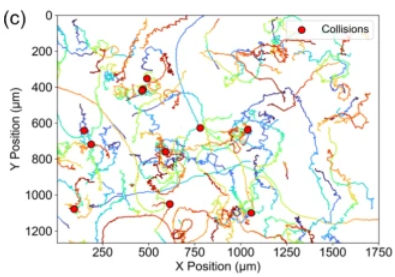EPJ E Highlight - Acanthamoeba castellanii offers a simplified model for density-driven cell migration
- Details
- Published on 24 July 2025

New analysis reveals that the motion of this unicellular amoeba is governed solely by cell–cell collisions, providing a useful model for isolating the effects of density on migration
Cell migration is vital to numerous biological processes. While often guided by long-range biochemical cues, it can also be influenced by direct physical collisions, which trigger biochemical signals within the affected cells. When studying this behaviour, it is important for researchers to consider how individual cell motions are affected by overall cell density. However, experiments have been complicated by the many interacting factors involved, making it difficult to isolate the specific impact of direct cell–cell collisions.
In new research published in EPJ E, a team led by Jean-Paul Rieu at Claude Bernard University Lyon 1 demonstrates how one unicellular amoeba species, Acanthamoeba castellanii (Ac), migrates in ways that are unaffected by long-range biochemical signalling – making it a promising model for studying how density influences cell migration. By using Ac, the researchers aim to gain deeper insights into the mechanisms of cell motion relevant to diverse biological processes, including immune responses, cancer cell invasion, and tissue development.
The frequency of collisions between migrating cells is directly influenced by cell density: as cells become more crowded, they collide more frequently. However, previous studies have reported conflicting results on how such interactions affect motion.
Rieu’s team analysed the trajectories of Ac cells using a classical model of random motion, which also accounts for short-term diffusive behaviour. Using a combination of experiments and theoretical modelling, they explored how cell motions are altered by collisions in crowded environments. They found that collision frequency plays a key role in linking density to the reorientation rate of migrating cells.
Their findings reveal that while individual Ac cells migrate at a constant speed, their direction of motion is governed entirely by collisions. At high densities, cells travel in straight lines between collisions – a behaviour rarely seen in eukaryotic organisms. These results establish Ac as a simplified model for studying cell migration in the absence of biochemical signalling. In turn, the researchers hope it could lead to improved methods for analysing cell migration in complex, high-density environments.
Ghazi, N., Demircigil, M., Cochet-Escartin, O. et al. Density-dependent cell migration in the absence of social interactions: a case study of Acanthamoeba castellanii. Eur. Phys. J. E 48, 42 (2025). https://doi.org/10.1140/epje/s10189-025-00502-6




